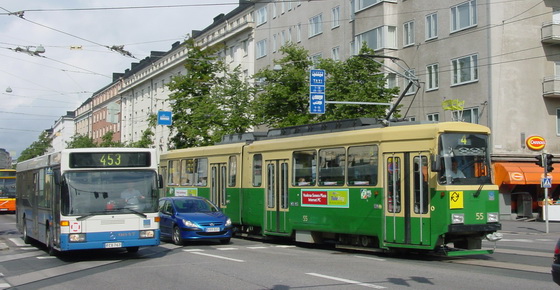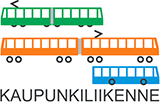
Public transport in Helsinki has dedicated lanes for buses and trams in main streets. Here a six lane Mannerheimintie is seen leaving only one lane for private cars. Signs for dedicated lanes can be seen on top of vehicles. AA 13.8.2001
Public transport in Helsinki
Only city with rails in Finland
Helsinki is the only city in Finland that has rail based public transport. To be precise, also the neighbour cities are served with rail transport with the commuter trains and western neighbour Espoo with metro extension opened in 2017. But the only tram and metro systems in Finland was in Helsinki since 1972 when Turku stopped it's tram system. Anyhow the situation will change at the end of 2010's, when City of Tampere proceeds with it's on going tram system construction.
Tram network is the original public transport system in Helsinki. Today it serves only the city centre and the nearest areas that are practically a continuity of the city centre. All the expansion of the city since 1950's is outside the tram network.
First low floor trams were delivered to Helsinki from 1999. Some minor extensions of tram lines has been built for few new areas, but Helsinki authorities has considered trams as slow street tram system not capable for suburban service. Still tram is faster than the metro to travel at the main street Hämeentie, where tram is parallel with the metro. This is because of the reserved tram lanes and partial tram priority in traffic lights. And because of the deep metro stations and long walking times, even though the metro trains are naturally fast.
Commuter trains connect suburbs and neighbour cities to Helsinki. They have own rails for the nearest distances from Helsinki, where the service frequency is high. Pure feeder bus service was planned for trains, but for public resistance part of the straight bus services has remained.
Most of the Helsinki suburbs and those parts in neighbour cities that are not served by rail are served with the bus lines straight to the city centre. All the lines end to one of the three bus terminals in the city centre. The westerns terminal, Kamppi, was converted to an underground terminal 2005 when a new shopping mall was built.
Helsinki metro is the latest implementation. The service started 1982 and the line was gradually extended to it's recent state with two branches in east and one in west. Next extension phase to west up to Kivenlahti in Espoo is under construction and may be finished in mid 2020's.
The first suburban tram projet, the orbital trunck bus line 550 conversion to a Light Rail line has started with the planning phase in 2017 and construction startin in 2019. Western end of the line is at Espoo side. Operation is estimated to start app. 2024.
Top of the page.
Optimistic growth estimates
Like many cities in Europe during 1960's, Helsinki believed to the practically endless growth. The estimate for year 2000 was 2 million inhbitants in only Helsinki. In 2000 the whole Helsinki metropolitan area (Helsinki, Espoo, Kauniainen and Vantaa) was slightly over one million.
The optimistic estimate was the background of the metro decision – besides the dreams of the train manufacturer Valmet to gain the world markets of metro trains. When these estimates never realized, the load planned for the metro never appeared. Valmet trains also vere never delivered elswhere than to Helsinki. Having the width of 3,2 meters cars were too large for most metro system in 1980's.
The problem with the Helsinki metro is both in it's size and the old fashion structure with third rail current supply. These prevent the track to cross any streets in plane and to fit the track line to the city structure. The eastern suburbs were originally planned to have German Stadtbahn style metro stations in the middle as in the green line in Stockholm, Sweden. But the metro engineers only stated, that it is impossible with the large scale dimensioning of the system and the line will be built aside the main roads.
The land use efficiency in Helsinki area is relatively low. Houses are usually 5 to 8 floor high, and the density in suburbs is so low, that there is not enough inhabitants in walking distance from a metro station. With the recent track building standard, metro track is too expensive to build to cover all the built area and to fit to the population density. To collect high enough passenger flows to the metro, a strong feeder bus system is required. To build a line long enough to collect passengers is both too expensive and exceeds the Helsinki city borders. For this reason the western extension to neighbour city Espoo took 40 years to start building.
The mistake of Helsinki metro is it's unflexibilty. It was designed to be able to carry the maximum possible passenger flow. But what was required was to be able to carry less passengers than estimated.
Though authorities never admitted the overcapacity, they did it in practice when the metro stations in the western extension were built one third shorter than previous stations. But it was too late and wrong way to fit system capacity to land use density. During 40 years metro had formed region's mobility structure to concentrate travelling to the metro line. Now every second train in Espoo is overcrowded during peak hours as only half of the trains operate west from Tapiola station.
Top of the page.
Cars still dominate
The modal split share of cars is relatively low in the city centre, 30 % of motorized transport. But at the whole Helsinki area it is near vice versa, 60 % for cars. One reason for this is that the public transport has not answered to the growth of the region. Traffic has increased at the orbital directions, where new and heavy loaded main roads has been built. But public transport connections lead to the city centre.
After the metro decision in 1969 Helsinki reserved own lanes for the trams and buses in the main streets in the city centre. But no real pedestrian area has been created. ”Car party” in Helsinki is strong and the possibility to drive through the heart of the city has been kept. Main traffic flow fills the only park Esplanaadi in the shopping area in the city centre. The number of cars in the city centre has remained the same since 1980's – as the capacity of the streets became filled already then.
Nowdays, when cities usually want to limit parking and car use in city centres, Helsinki plans opposite. Number of parking places will grow with new underground parking sites and by reorganizing street parking. A huge city tunnel plan to increase number of car trips through the city with 25.000 trips per day is going strong. Though it was already once rejected in 2008. Still no real car free zone in the city will be arranged.
Helsinki region has the same problem as many other cities in Europe: urban sprawl. Both the industry, shopping and living are looking for less expensive land and space to grow. The competition between the independent cities and municipalities around Helsinki is the power for this development. As there is no real central planning for land use, the only solution for traffic is road traffic.
Unfortunately it seems to be that the attitude of the planners is also for car. It is easy to not to care about traffic, as roads has to be built anyway. The main roads and motorways are not the part of the planning of a single suburb, so road capacity is not the problem of the planner. Only problem is to reserve parking space for the cars with houses.
Most of the planners are not familiar with the modern public transport solutions. They know only the too expensive metro, which is allways too expensive for any project. And anyway, the only line is never even near, so no need to care about it.
In 2017 Helsinki City council accepted totally new shaped master plan. Availability of housing has been a long term problem in Helsinki. The new master plan is based on converting motorways near city centre to boulevards with housing aside. Tram lines on the bulevards are the model of mobility. The master plan had political strong support, but state's road traffic authorities appealed for the master plan argumenting it is illegal to convert motorways to streets. For this reason, the superior court cancelled part of the boulevard plans.
Top of the page.
Basic numbers
The original Helsinki before the incorporation of Östersundom area in 2009 has 555,000 inhabitants and population density is 3020 pers./sqkm. Helsinki region urban area has 1.2 million inhabitants with population density of 405 pers./sqkm. Urban area includes plenty of forest, so the population density at the built areas varies from 1000 to 1700 pers./sqkm. Exception from this is the old city centre of Helsinki, which reaches partly over 10,000 pers./sqkm.
The 120 units tram fleet carries daily 193,000 passengers. 108 metro coaches carry 182,000 passengers (before the Espoo branch opening) and 167 commuter trains carry 88,000 passengers. So the trams are the most important public rail transport system even though the network covers only the city centre area of Helsinki. These figures will change as a consequence of the western Espoo metro extension which transfers bus passengers to be also metro passengers. It is also good to understand, that number of trips is remarcable less than the sum of boardings. Majority of metro passengers board bus and metro during one trip.
Page is created at 9.10.2007 / AA. Latest update 10.6.2019 / AA.
